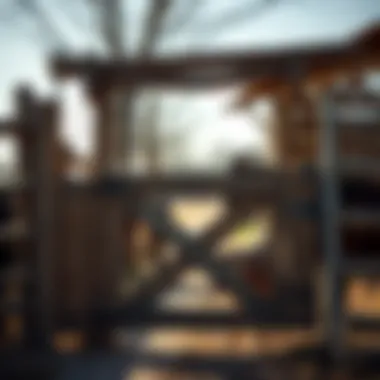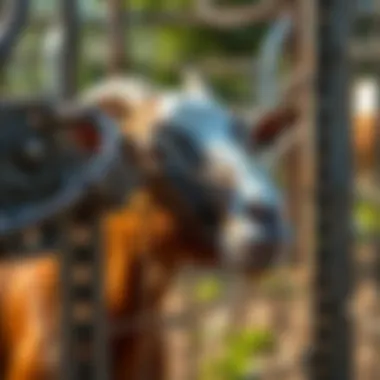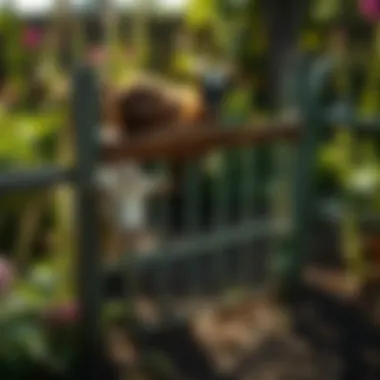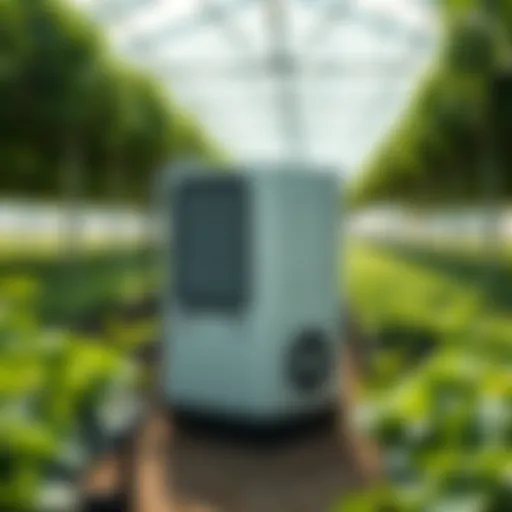A Complete Guide to Buying Goat Gates


Intro
When it comes to managing livestock, particularly goats, the importance of efficient fencing cannot be overstated. Goat gates play a pivotal role in this arena, providing not only access but also security for your animals. This article aims to explore the nuances of goat gates available for sale, allowing farmers and gardening enthusiasts to make well-informed choices tailored specifically to their unique needs.
As trends in farming continue to evolve, understanding the types of gates, their applications, and the entire installation process is essential. Prioritizing factors such as durability, climate impacts, and specific requirements of goats can significantly elevate the ability to manage these spirited animals. This guide aims to demystify the market's offerings while ensuring that you harness the maximum potential of your goat infrastructure.
Preface to Goat Gates
Goat gates play a crucial role in the management and organization of livestock, specifically goats, on farms and homesteads. In this article, we shall explore the various aspects related to goat gates, providing a clear, comprehensive overview intended for agricultural farmers and enthusiasts.
Purpose of Goat Gates
The primary purpose of goat gates is to create controlled access for goats within pastures and enclosures. This not only helps in ensuring the safety of the livestock but also aids in the effective management of grazing areas. Imagine a sprawling field dotted with lush grass; without these gates, goats could wander off into the neighbor's yard or into untamed terrain, where they could potentially encounter dangers or destroy crops. Goat gates act as barriers, keeping our curious friends where they need to be.
Moreover, goat gates can serve other functions such as:
- Facilitating Pasture Rotation: Moving goats from one grass patch to another allows for optimal grazing, preventing overgrazing in one area.
- Organizing Space: A well-structured approach to using gates allows farmers to create an orderly environment where goats can be channeled conveniently during feed times or veterinary checks.
- Enhancing Security: With sturdy and properly installed gates, farmers can deter untamed predators and unauthorized access to their herds.
In simpler terms, goat gates act as the silent sentinels of livestock management, guarding not only the goats but also the farmer's peace of mind.
Importance in Agricultural Practices
In agricultural practices, the significance of goat gates extends beyond mere functionality. They contribute substantially to the welfare of the animals and the operational efficiency of the farm. When it comes down to it, a well-thought-out gate system is an indispensable component of any effective animal husbandry strategy.
Farmers who employ gates wisely often notice several benefits, including:
- Improved Herd Health: By controlling movement and interactions, the risk of disease transmission within herds may be minimized.
- Streamlined Operations: Efficient gate management helps in reducing the time and resources spent on daily livestock handling. Less time spent chasing wayward goats means more time managing other essential farm operations.
- Customization for Diverse Needs: Some goats may require specific care based on age, breed, or health status. Gates allow farmers to separate animals easily and cater to unique needs without a fuss.
"A well-placed gate is like having an extra hand on the farm, aiding in both safety and productivity."
In summary, understanding the significance of goat gates in agricultural practices can lead to more effective livestock management. A straightforward setup not only offers utility but also reflects a farmer's commitment to best practices in animal husbandry.
Types of Goat Gates
In the realm of livestock management, selecting the right type of gate can make all the difference. Goat gates do more than just keep the animals contained; they provide security, control access, and facilitate ease of movement around the farm or garden. Understanding the various types of goat gates available helps in making informed choices that cater to specific needs and conditions.
Swing Gates
Swing gates are perhaps the most traditional and widely recognized type of gate. They operate on hinges, allowing for a straightforward opening and closing mechanism. One distinct advantage of swing gates is their robustness; they can be built from various materials like wood, metal, or composites. This flexibility allows them to serve in different environments, from rustic farms to more organized pastures.
A swing gate can be particularly beneficial on flat terrain. It doesn’t require complicated mechanisms, making it easy to install and maintain. However, a farmer should consider the space requirements; they need clear room to swing open without obstructing any pathways or animal movement. Let’s also note that in areas with heavy snow or mud, swing gates can garner natural buildup, complicating their operation.
Sliding Gates
Sliding gates present another efficient option for managing goat access. Instead of swinging open, these gates slide along a track, making them ideal for narrow spaces where a traditional swing gate would be impractical. They can handle larger openings, making them suitable for high-traffic areas.
Why choose a sliding gate?
- Space Optimization: They take up less space compared to swing gates.
- Smooth Operation: Many sliding gates come equipped with wheels, providing ease of use, especially for heavy-duty applications.
- Durability & Safety: Constructed from sturdy materials, they can withstand more force, deterring goats from pushing against them.
In some farming setups, a sliding gate could act as a barrier for differing grazing areas, enhancing pasture management while keeping the goats from roaming where they shouldn’t.
Portable Gates
For those who value flexibility, portable gates can be a game changer. As an ideal solution for rotational grazing, they allow farmers to create temporary enclosures without the hassle of permanent installations. This adaptability aids in pasture care and soil regeneration by allocating grazing areas based on the goats’ needs.
Portable gates are typically lightweight, making them easy to move and adjust as required. Mainly made from materials like plastic or lighter metals, they offer convenience while sacrificing some durability. Thus, it’s essential to handle them with care, especially in harsher climates. They work well with other gate types, providing dynamic solutions.
"To make the most of your pasture, it's crucial to keep your goats on the move. Portable gates provide that flexibility like no other."
Electric Gates
Electric gates are becoming more common in agricultural settings, particularly for those managing larger herds. They provide an automated solution that can be integrated into a farm’s overall management system. These gates can differentiate between animals and manage larger areas with ease.
The benefits of electric gates include:
- Automation: They can be controlled remotely, helping reduce the need to physically check all enclosures.
- Security: The electric element deters potential breaches from both goats and wildlife, adding extra safety to your investment.
- Custom Alerts: Some systems allow alerts for any breaches or mistakes in gate operation, ensuring a high level of monitoring.


However, ensure that you install reliable power sources and have backup systems in place. Dependence on electricity means you need to consider the potential for outages, and that could leave your herd at risk.
In summary, when choosing a goat gate, it’s essential to weigh their advantages against any limitations. Whether it's the traditional swing gates, the efficient sliding types, the versatile portable ones, or the modern electric gates, each has its role in successful goat management.
Factors Influencing Goat Gate Choice
Choosing the right goat gate isn't as simple as picking whichever looks nice. It involves a careful analysis of several aspects based on the specific needs of the farm or property. Each choice can either facilitate goat management or create an unnecessary headache. Therefore, understanding these factors can save you time, effort, and money in the long run.
Size and Dimensions
Size is a primary consideration when selecting a goat gate. It’s essential to measure the space in which the gate will be installed. A large gate can facilitate easy movement, especially during feeding times, but it might take up more area than necessary. Conversely, a smaller gate could restrict movement, leading to frustration for both the farmer and the goats.
When you measure, be sure to account for the height as well, as different goat breeds may have varying heights and behaviors. An adequately sized gate not only enhances functionality but also ensures that your goats won’t feel trapped or stressed.
Material Considerations
The material used in constructing your goat gate plays a substantial role in its longevity and durability. Here's a rundown of common materials used:
Wood
Wood gates can give a rustic charm, making them an attractive choice. The key characteristic of wood is its natural aesthetic, providing a warm feel to your farm environment. However, wood can be vulnerable to rot and insect damage if not treated adequately. Regular maintenance of wooden gates is imperative for durability. They do come with the uniqueness of being easily customizable. This allows for personal touches, such as different paints or styles that suit your farm landscape, showcasing individuality.
Metal
Metal gates are often recognized for their strength and durability. They can withstand rough usage and adverse weather conditions much better than wood. The unique feature is that metal gates are typically much heavier and can be more secure, which is excellent for those worrying about predators. However, installation can become a more challenging task, needing more tools or help. Corrosion can also be a concern, particularly in humid areas. Using galvanized steel or other treated metals can mitigate this issue.
Plastic
In recent years, plastic gates have started gaining traction. They are lightweight and usually resistant to weather elements, which is a significant advantage in areas with extreme climates. The key characteristic of plastic is that it won't rust or corrode, and cleaning is straightforward, requiring little more than a hosing down. On the downside, they might not offer the same level of security as wood or metal gates, particularly if thicker, sturdier animals are involved.
Intended Use
The purpose of the gate will largely dictate the features you require. For example, gates primarily for pasture access will differ in design and strength compared to gates used in a temporary enclosure or for livestock transport. Considering how often the gate will be used and what it needs to withstand is crucial.
Would you need a pass-through gate for everyday access, or a more robust option for safety in a commercial operation? Identifying your intended use will streamline the selection process and ensure you get the best gate for your situation.
Benefits of Installing Goat Gates
Installing goat gates offers a multitude of advantages that enhance both the functionality and security of your farm or garden environment. These gates do more than just serve as entry or exit points; they play a vital role in managing livestock, maintaining organization, and ensuring the safety of your goats. Let's explore the specific benefits that come with installing goat gates.
Enhanced Security for Livestock
In any farming operation, security is paramount. Goat gates are designed to provide robust barriers that keep your goats safe from predators and straying into potentially dangerous areas. For instance, a well-installed metal or electric gate can deter unwanted wildlife like coyotes or stray dogs that may pose a threat. Moreover, goat gates help to minimize escapes, ensuring that your livestock remains within designated areas. This is especially critical in urban or semi-urban settings where wandering animals can lead to accidents or conflicts with neighbors. By investing in or constructing high-quality gates, farmers can significantly lower the risk of losses attributable to theft or predation, thus safeguarding their investment in livestock.
Improved Organization in Pastures
A well-organized pasture is crucial for optimal goat management. Installing goat gates allows for better segregation of different herds or breeds, which is essential for breeding programs or health management. For example, if you have a mix of dairy and meat goats, separate pastures help in managing their distinct nutritional and care needs.
Additionally, by directing livestock traffic, goat gates help prevent overcrowding in certain areas of the pasture. This not only promotes healthier grazing habits but also reduces soil erosion and overgrazing, contributing to a sustainable farming practice. An organized layout within your farm can also streamline daily operations, making tasks such as feeding and veterinary checks more efficient.
Facilitating Herd Management
Managing a herd of goats requires constant attention and flexibility. Goat gates contribute significantly to this by enabling easier movement of animals between different areas of the farm. Whether you're herding them into a barn for shelter during bad weather or guiding them to specific grazing spots, having functional gates simplifies the process.
In addition, specific designs like sliding or portable gates can be particularly useful on varied landscapes. They allow for swift adjustments when needed, such as during seasonal changes or during the introduction of new animals into an existing herd. This flexibility is indispensable for effective herd management, as it ensures that farmers can adapt quickly to changes in their operational needs or environmental conditions.
"Investing in goat gates not only secures your livestock but also promotes healthy grazing and efficient herd management."
Cost Considerations for Goat Gates
When thinking about goat gates, the cost is a crucial bit of the puzzle. These gates act as the gatekeepers (pun intended) of your livestock, influencing not just the management but the safety of your goats. Understanding the financial aspect ensures you’re not just picking a gate blindly but selecting one that aligns with your budget and needs.
Investing in quality gates often pays off in the long run, reducing the chances of needing repairs and replacements. Moreover, knowing how much you’re willing to spend can help you make informed decisions on materials, types, and features that matter most for your farm or homestead.
Average Price Range
If you step into a store, or browse online for goat gates, you might find prices stretching wildly across the board. On average, you’re looking at anywhere from $100 to $1,500.


- Basic Swing Gates might cost between $100 to $300, suited for smaller setups.
- Sliding and Portable Gates often fall in the $300 to $700 range, given their flexibility and ease of use.
- If you’re leaning towards durable materials or specialized electric gates, you could be shelling out anywhere from $800 to $1,500.
It’s essential to balance the gate’s role in your environment with what you feel comfortable spending.
Factors Affecting Pricing
Several components can affect what you end up paying for goat gates. Let’s break it down a bit:
- Material: The choice between wood, metal, or plastic can significantly sway the price.
- Size: Bigger gates mean more material and likely higher costs. If you're working with larger livestock, this is a serious consideration.
- Gate Type: Swing or sliding mechanisms will have differing price tags. Electrified versions come at a premium due to their tech.
- Market Dynamics: Local demand and supply can drive up prices or leave you with a bargain. Sometimes, you'll find that buying seasonal or off-peak can save some bucks.
- Branding: Name-brand gates may carry a higher price tag thanks to their reputation, even if others do the job just as well.
It’s a good idea to shop around and compare. You may stumble upon sales or discounts that can make a world of difference in your budget.
Budgeting for Installation
Once you’ve nabbed the right gate, budgeting for installation is another nut to crack. Here are some elements to consider:
- DIY Installation: If you possess basic handyman skills, you may opt to install it yourself. This can save you a good chunk of change.
- Professional Help: Hiring someone to do the installation can range from $200 to $500, depending on complexity. Make sure to get quotes before settling.
- Tools Needed: If you’re taking the DIY route, factor in tools and materials you might lack. A simple gate may require nothing but some screws and a drill, but a more complex utility may need specialized equipment.
- Time Consideration: Don’t forget to factor in your own time. Sometimes, it’s worth hiring a pro to escape the headaches that come with mismatched fittings or bending metal.
In sum, understanding all the financial sides of goat gates leads to far better decisions that enhance both your pocket and your livestock’s safety.
Where to Find Goat Gates for Sale
Finding the right goat gate is crucial for effective livestock management. Whether you're a seasoned farmer or a newcomer to the goat-keeping world, knowing where to source these gates can save you time and expense. In this section, we will explore different avenues to buy goat gates, discussing the benefits and considerations for each option.
Local Agricultural Supply Stores
Local agricultural supply stores are often the first stop for many farmers seeking goat gates. These businesses typically understand regional needs and can provide advice tailored to your farming conditions. They often stock a variety of gates, tailored for local livestock breeds and habits.
When you shop at a local store, you get the chance to physically assess the gates. You can check things like the materials used, weight, and overall quality. Moreover, buying locally supports your community and keeps your money circulating in local economies. Sometimes, these stores also offer special deals or discounts for bulk purchases, which can be beneficial if you're outfitting more than one pasture.
Online Retailers
The internet has changed the game when it comes to shopping for livestock equipment, including goat gates. Websites like Amazon, Tractor Supply Co., and others allow you to browse a wide selection without ever leaving your home. This opens the door to compare prices, styles, and features from the convenience of your couch.
One of the standout benefits of online shopping is access to customer reviews. Seeing what other buyers have to say about specific gates can significantly inform your decision. Just keep in mind shipping costs and delivery times. Depending on your location, it may take some time for gates to arrive, especially if they are large or heavy.
"Purchasing online gives you a broader view, but make sure the product matches your needs before clicking that 'buy' button."
Second-Hand Markets
Exploring second-hand markets for goat gates can be a smart and economical choice. Websites like Craigslist, Facebook Marketplace, and even local farming co-ops sometimes have listings for used gates. The initial lower price can be tempting, but there are a few thoughts to wrap your head around.
Inspecting a second-hand gate thoroughly is essential. Look for signs of wear or damage that could affect its usability. If it's being sold in a local area, you may have the opportunity to inspect it in person before committing. At times, farmers simply need to sell while upgrading or changing their setups, meaning you can score good quality for less.
Installation Considerations
When it comes to goat gates, the installation considerations can make or break your overall experience. Proper installation ensures not just functionality but also durability and safety for your livestock. It’s not just about putting up a gate; it’s about creating an environment where your goats can roam freely while being contained effectively. Proper planning and execution of the installation process is key to avoid future issues.
Preparation and Planning
Before you even think about drilling holes or measuring spaces, it’s crucial to take a step back and draft a clear plan. Without a blueprint of sorts, the installation might become a fiasco. Here are some steps you should take during the preparation stage:
- Assess the Area: Start by checking the specific area where you plan to install the gate. Look for any obstructions, uneven terrain, or other potential challenges.
- Choose the Right Gate: Based on your requirements—such as size, material, and intended use—select a gate that fits your need. Think about how often you’ll be using it and the kind of traffic it will bear.
- Gather Tools and Materials: Make sure to have all necessary tools at hand. A simple checklist might include:
- Post hole digger or auger
- Level
- Tape measure
- Hinges and latches suitable for your gate
- Safety gear (gloves, goggles)
Taking time upfront for preparation will save you a headache down the line.
Step-by-Step Installation Guide
Now that you’ve prepped the ground, so to say, let’s dive into the installation process. Here’s a simplified guide:
- Mark the Location: Use stakes to outline where the gate should go. This helps you visualize the final result.
- Dig Post Holes: If you’re installing a standard gate, you’ll need posts. Dig holes about 2 feet deep to ensure solid structural support.
- Set Posts: Place the posts in the holes and level them. Pour concrete or dirt around them for stability, ensuring they’re upright.
- Attach Hinges: Depending on the design of your gate, attach hinges on one side, ensuring they're securely fixed.
- Hang the Gate: Lift the gate into place and attach it to the hinges. Make sure it swings freely and doesn’t scrape the ground.
- Install Latch and Latch Post: On the opposite side of the gate, install the latch. Check that it engages securely.
- Final Checks: Stand back and inspect the installation. Make sure everything is level and functional.
Following these steps will help make the installation process straightforward.
Common Installation Mistakes to Avoid


Even seasoned hands can run into pitfalls when it comes to installing gates. Here are some common snags to watch out for:
- Ignoring Ground Conditions: Always consider the surface upon which the gate stands. If the ground’s uneven or has too much slope, it can lead to position issues.
- Neglecting to Level Posts: Failing to level the gate can cause operational difficulties later. A gate should open and close without obstruction.
- Using Subpar Materials: Cut-rate materials might save a few bucks initially, but they'll cost you in the long run. It’s best to invest in quality materials.
Remember, a single mistake during installation might lead to repeated expenses and stress.
While it may sound tedious, planning is half the battle. Good installation leads to functional and efficient goats management. Plus, it’ll save you a boatload on repairs later. So take your time, do it right, and make sure your goats are happy and secure.
Maintenance of Goat Gates
Proper maintenance of goat gates is more than just a chore; it's an essential aspect of successful livestock management. Regular upkeep ensures not just the longevity of the gates but also minimizes risks associated with faulty fences, which can have dire consequences for both the goats and the agricultural setup. Let's unpack what this entails and explore its merits in a bit more detail.
Routine Checks and Repairs
Routine checks play a pivotal role in ensuring that your goat gates are functioning like a well-oiled machine. Regular inspections can uncover small issues before they snowball into major problems. Here’s what you might consider during your checks:
- Look for Wear and Tear: Inspect hinges, latches, and the gate frame for signs of rust or damage.
- Test Movement: Open and close the gate to ensure it swings freely. Any stiffness might signal the need for lubrication or adjustment.
- Check for Stability: Make sure the gate is firmly anchored and there’s no wobbling. This helps in preventing any unexpected breaches.
- Evaluate Entrance Points: Ensure that the gates align correctly with the fencing to prevent gaps through which goats might escape.
Here's a nifty checklist:
- Inspect gates every month.
- Tighten any loose screws or bolts.
- Clean dirt and debris from hinges and tracks.
- Lubricate moving parts to prevent rust.
If repairs are needed, take action promptly. A small crack can become a larger split with time and weight, potentially leading to an escape artist in your herd.
Long-term Care Tips
If you want your goat gates to stand the test of time, consider the following long-term care tactics:
- Choose Quality Materials: Invest in galvanized or stainless steel options as they resist rust and corrosion, thus reducing maintenance needs.
- Seasonal Maintenance: Before winter hits or after heavy rains, do a thorough inspection. Harsh weather can exacerbate wear.
- Keep Equipment Handy: Have your tools and supplies close by. A bucket of screws, a hammer, and lubricant can make repairs a breeze.
- Educate Staff: If you are managing a team, make sure everyone understands the importance of gate maintenance and how to spot potential issues.
Taking these steps not only preserves the gate but also contributes to overall herd safety.
"An ounce of prevention is worth a pound of cure", as the saying goes; it holds particularly true here. By maintaining your gates, you protect your investment and your livestock. In agriculture, neglecting these elements can yield more than just financial losses; it can also mean the well-being of your herd. So, keep those gates in check and keep your goats where they should be.
Environmental Considerations in Goat Gate Usage
Understanding the environmental implications of goat gate usage is increasingly critical as we strive for sustainable agricultural practices. In this section, we’ll explore how designing and choosing the appropriate gate can not only enhance farm management but also protect our natural surroundings. Goat gates act as a crucial barrier in defining areas where livestock can roam while simultaneously intersecting with local ecology. Thus, their design and material choices can significantly impact the environment—the butterfly that flaps its wings in a neighboring landscape can echo loud and clear in agricultural practices, after all.
Sustainability of Materials
When it comes to sustainability in the context of goat gates, it isn't just about putting a gate in place; it's about selective sourcing of materials that leave minimal ecological footprints. You're not simply creating a partition; you're making a statement about being environmentally responsible.
Choosing sustainable materials helps reduce each farm’s impact on the ecosystem. Common materials include:
- Wood: While traditional, it's essential to opt for treated and certified wood sourced from sustainable forests. This ensures your gate has a lesser likelihood of harming local flora and fauna.
- Metal: Over the years, recycled metal has gained popularity due to its durability and strength. It’s weather-resistant, which means less maintenance and replacement, leading to reduced waste in the long run.
- Plastic: UV-resistant recycled plastic can be a practical choice, particularly for portable gates. While it mimics the traditional look, it doesn't decay like wood, making it a reliable option.
Opting for gate materials like these not only bolsters the structure but also showcases a conscious effort towards maintaining environmental integrity. It's almost like wearing a badge of honor in the world of sustainable farming.
Impact on Wildlife
Another dimension of goat gate usage that often goes unnoticed is its impact on wildlife in the vicinity. Goats are curious creatures, and while they can be efficient grazers, they also have the potential to inadvertently disturb local ecosystems. Proper gate design should consider local wildlife habits. For instance, utilizing gates that enable safe passage for smaller animals can prevent habitat fragmentation.
Moreover, adequate gate placement can:
- Reduce Wildlife Encounters: Strategic positioning of gates can help in keeping goats isolated from sensitive wildlife areas. This way, you can protect local fauna while still allowing your herd some freedom to roam.
- Support Eco-corridors: By avoiding obstruction paths that animals frequently use, farmers can support wildlife migration patterns, thus contributing to biodiversity.
The End
In wrapping up our exploration of goat gates, it's apparent that these installations are more than just simple barriers. They serve a pivotal role in ensuring the safety and management of livestock while facilitating ease of access to various areas of a farm or garden. Understanding the nuances of goat gates can aid agricultural enthusiasts and farmers in making informed choices that not only enhance productivity but also contribute to better animal welfare.
Summarizing Key Points
As we digest all the information presented above, a few central points emerge that summarize the essence of goat gates:
- Variety of Types: Various types of goat gates, including swing, sliding, portable, and electric, offer different advantages depending on the specific needs of a farm. Each type comes with its own features that can enhance efficiency and effectiveness.
- Cost Considerations: Pricing can vary greatly; thus, being strategic about budgeting is essential. Understanding what factors influence costs can help you select the best option without breaking the bank.
- Environmental Impact: The materials used in goat gates can have ramifications for the environment. Opting for sustainable options not only benefits your farm but also the broader ecosystem.
- Installation and Maintenance: Proper planning and maintenance are crucial in ensuring the longevity and functionality of goat gates. Avoiding common pitfalls can save time and money.
Final Thoughts on Goat Gates
Navigating the world of goat gates is no simple task, but it's a worthy endeavor for anyone serious about their farming practices. With the right gate, not only does your herd become more manageable, but the operation of your farm can streamline significantly. As we conclude, consider the time and effort you invest in selecting a goat gate as a pivotal step towards creating a secure, organized, and efficient farming environment. Always remember that the choice of equipment should reflect both your practical needs and philosophical values towards livestock care. Balancing functionality with sustainability is key for long-term agricultural success.
Choosing the right gate isn't just a matter of preference; it's about enhancing the life quality of your herd and ensuring your operations run smooth.
As you embark on this journey, weigh the insights shared in this guide, and approach your decisions with a clear vision of what aligns with your farming goals.







